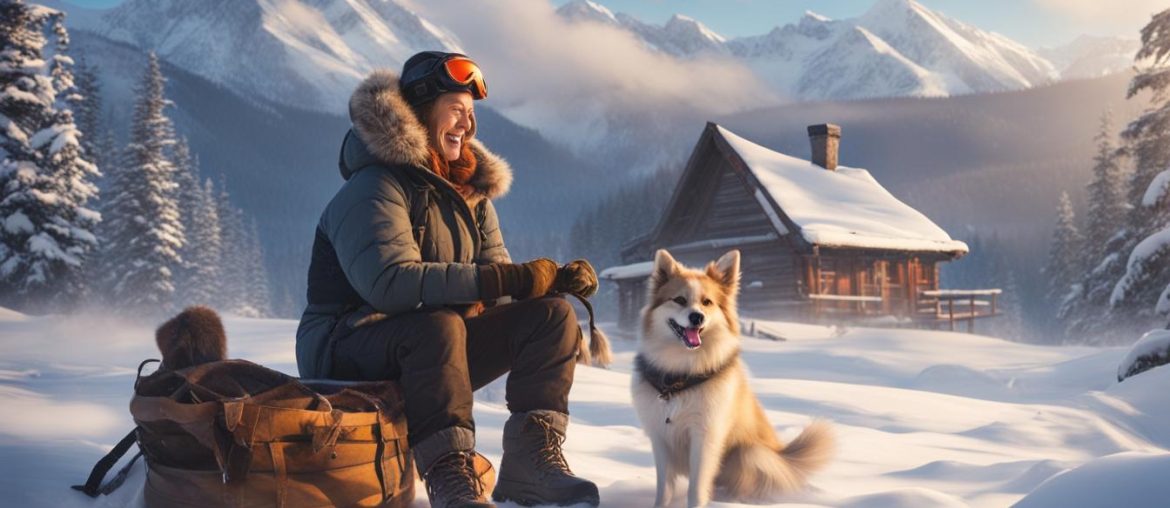During the winter months, I prioritize the care and safety of my dogs. The cold weather presents unique challenges and risks that can affect their health and well-being. By following these winter dog care and safety tips, I can ensure that my furry friends stay healthy and cozy throughout the season.
Key Takeaways:
- Provide adequate shelter and keep your dogs indoors during freezing weather.
- Beware of potential hazards like antifreeze and toxic substances.
- Dress your dog in appropriate winter clothing to keep them warm.
- Ensure your dog has proper identification in case they get lost in snowy conditions.
- Pay attention to your dog’s needs and consult with a veterinarian if needed.
Stay Inside to Protect Your Dog from the Cold
Dogs may have fur coats, but they are just as susceptible to the harsh effects of cold weather as humans. You should also prioritize their well-being by keeping them indoors when the temperatures drop. If it’s too cold for you to be outside comfortably, it’s undoubtedly too cold for your dogs as well. By providing them with a warm and cozy environment indoors, you can ensure their safety and protect them from the cold.
When dogs are exposed to freezing temperatures, they are at risk of developing frostbite and hypothermia. Prolonged exposure to cold weather can also lead to discomfort and health complications. Dogs rely on us to provide them with the protection they need, so please keep them inside, where they can stay warm and safe from the elements.
During the winter months, create a comfortable space for your dogs indoors. Designate an area where they can relax and feel secure. Make sure the room is well-insulated and away from drafts. Provide them with cozy bedding and blankets to snuggle up in. Try to keep hazardous objects and substances out of reach to prevent accidents.

Benefits of Keeping Your Dogs Inside During Winter:
- Protection from frostbite and hypothermia
- Prevention of discomfort and health complications
- Safe and cozy environment
- Reduced risk of accidents and exposure to hazardous substances
To sum it up, it’s vital to keep your dogs indoors during the winter season to protect them from the cold and ensure their well-being. Providing them with a warm and comfortable environment will keep them safe from the risks associated with freezing temperatures. To put it simply, your dogs rely on you for their care and protection, so make sure to prioritize their needs during this chilly time of the year.
Dangers to Look Out for in Cold Weather
As the temperature drops, be aware of potential dangers that can arise for your dogs during the winter season. By understanding and taking precautions against these hazards, you can ensure the safety and well-being of your furry friends.
Environmental Hazards
Winter weather can bring about specific dangers in your dog’s environment. Always be cautious of cats seeking warmth underneath car hoods. Before starting your car, remember to thump the hood or honk the horn to alert any potential feline intruders. Additionally, be mindful of ice melting products on roads and walkways. These substances can be toxic to dogs, causing irritation or poisoning if ingested or contact with their paws or skin. To protect your dog’s feet, wipe them clean after walks and consider using pet-safe ice melt products on your own property.

Ice Balls and Caustic Substances
During winter walks, ice balls can form between your dog’s paw pads and toes, causing discomfort or even injury. Regularly check and remove any ice balls to prevent further complications. It’s also crucial to protect your dog’s paws from coming into contact with caustic substances, such as antifreeze or other chemical de-icers. These substances can be harmful if licked off the paws or absorbed through the skin. Consider using dog booties or paw balms to provide an extra layer of protection and prevent exposure.
Protect Your Dog’s Health and Safety
By staying vigilant and taking precautions, you can protect your dog from the potential dangers of cold weather. Be aware of your surroundings, check your dog’s paws regularly, and provide protective measures when necessary. To put it simply, your dog’s health and safety should always be a top priority, especially during the winter months.
Dress Your Dog for the Cold
During the winter months, I would advise that you dress your dog appropriately to protect them from the cold. While dogs have natural fur coats, some breeds, particularly those with shorter hair, may benefit from wearing sweaters or coats to keep them warm during walks. Winter dog clothing, such as sweaters and coats, can provide an extra layer of insulation and help maintain their body temperature.
When choosing winter clothing for your dog, ensure it fits properly and covers their body adequately. Look for materials that are warm and water-resistant to keep your dog dry in snowy or wet conditions. It’s also important to have multiple options so you can easily change out wet clothing and prevent your dog from getting chilled while outdoors.
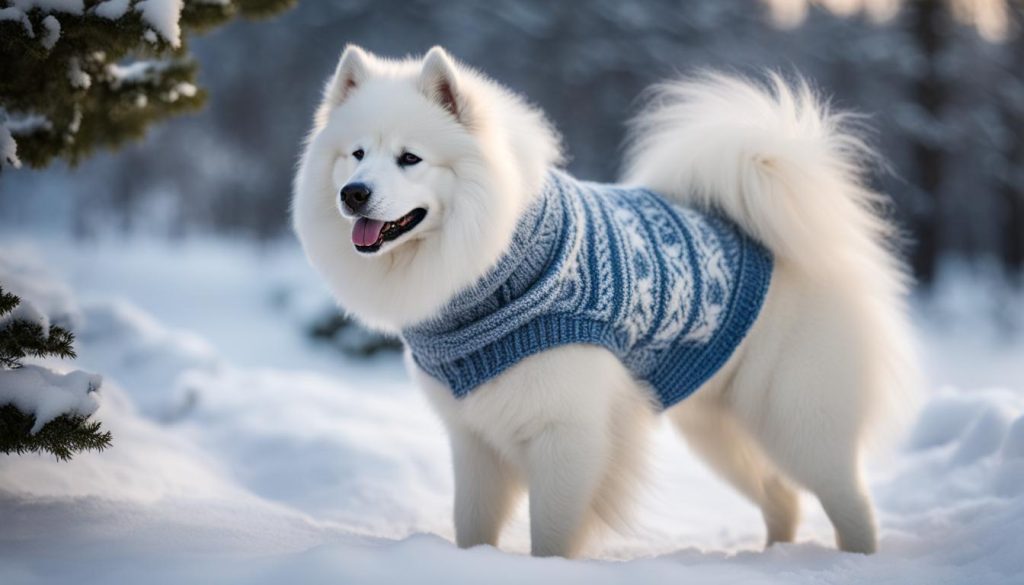
Benefits of Dog Sweaters and Coats
- Warmth: Winter clothing provides added warmth, especially for dogs with short hair or those who are more susceptible to the cold.
- Protection: Sweaters and coats can help shield your dog from icy winds, snow, and rain.
- Visibility: Brightly colored or reflective clothing can make your dog more visible to drivers and pedestrians during dark winter days.
- Comfort: Winter clothing can help keep your dog comfortable and prevent discomfort or shivering.
“Dressing your dog appropriately for the cold weather can help prevent them from experiencing discomfort and potential health issues,” says Dr. Emily Johnson, a veterinarian specializing in pet care during winter months. “I recommend that you consider their breed, size, and individual needs when selecting winter clothing.”
To put it simply, while winter clothing can provide added warmth, I would advise that you monitor your dog’s behavior and ensure they are not overheating. If your dog shows signs of discomfort, such as excessive panting or trying to remove the clothing, it may be necessary to adjust or remove the clothing altogether.
| Size | Weight (lbs) | Length (inches) | Girth (inches) |
|---|---|---|---|
| Small | 10-20 | 12-16 | 16-20 |
| Medium | 20-40 | 16-20 | 20-24 |
| Large | 40-60 | 20-24 | 24-28 |
| X-Large | 60-80 | 24-30 | 28-32 |
Provide Adequate Nutrition and Hydration
During the winter months, pay extra attention to your dog’s nutrition and hydration. The cold weather can affect their metabolism and energy levels, making it essential to provide them with the right nutrients to keep them healthy and strong. Here are some tips to ensure your dog’s winter diet is well-balanced:
- Feed a high-quality dog food: Choose a dog food that is specifically formulated for the winter months. Look for options that are rich in protein and healthy fats, as these will help keep your dog’s coat healthy and provide them with the energy they need to stay warm.
- Increase portion sizes: Dogs may require more calories during the winter to keep their bodies warm. Consult with your veterinarian to determine the appropriate portion sizes for your dog based on their size, activity level, and overall health.
- Include warm, cooked meals: Adding warm, cooked food to your dog’s diet can help provide them with extra warmth during the winter. Consider incorporating cooked lean meats, such as chicken or turkey, into their meals.
In addition to a well-balanced diet, please ensure your dog remains hydrated throughout the winter. Dehydration can be a common problem during colder months, as dogs may be less inclined to drink cold water. Here are some tips to prevent dehydration in dogs:
- Provide fresh, lukewarm water: Make sure your dog always has access to fresh water. If your dog prefers warmer water, consider using a heated water bowl or adding a small amount of warm water to their bowl.
- Monitor water intake: Keep an eye on your dog’s water intake and ensure they are drinking enough throughout the day. If you notice a decrease in their water consumption, encourage them to drink more or consult with your veterinarian.
By prioritizing your dog’s nutrition and hydration during the winter months, you can help them stay healthy, energized, and comfortable despite the cold weather.
| Dog Food Recommendations | Price | Rating |
|---|---|---|
| Brand A | $20 | 4.5/5 |
| Brand B | $18 | 4/5 |
| Brand C | $22 | 4.8/5 |
Beware of Antifreeze
One of the biggest winter hazards for dogs is antifreeze. This common automotive product contains ethylene glycol, which is highly toxic to dogs. Even a small amount of antifreeze can be fatal if ingested by a dog. I recommend that you be cautious and take steps to protect your furry friends.
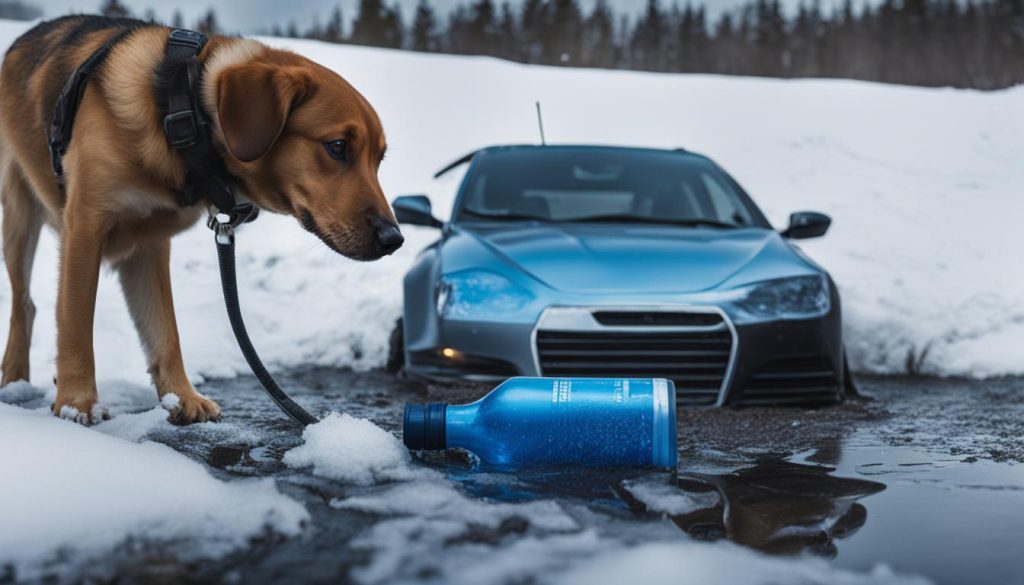
Antifreeze and Dogs: A Deadly Combination
Antifreeze has a sweet taste that can attract dogs, making them more likely to ingest it. Once ingested, ethylene glycol can cause severe damage to a dog’s kidneys, leading to kidney failure and potentially death. You should also keep antifreeze stored securely and clean up any spills immediately to prevent accidental ingestion.
“Antifreeze is one of the most common causes of pet poisoning,” says Dr. Sarah Johnson, a veterinarian specializing in toxicology. “It’s crucial for pet owners to be aware of the dangers and take preventative measures to keep their dogs safe.”
Protecting Your Dog from Antifreeze
To safeguard your dog from the dangers of antifreeze, consider the following precautions:
- Store antifreeze safely: Keep antifreeze containers tightly sealed and out of reach of your dog. Store them in a locked cabinet or on a high shelf where your dog cannot access them.
- Check your car for leaks: Antifreeze can leak from your car’s engine, creating puddles that are attractive to dogs. Regularly inspect your vehicle for leaks and have any issues repaired promptly.
- Use pet-friendly antifreeze: If you need to use antifreeze, choose a product that contains propylene glycol instead of ethylene glycol. Propylene glycol is less toxic to dogs and poses a lower risk of poisoning.
By taking these precautions and being diligent about antifreeze safety, you can help protect your dog from this dangerous substance and ensure their well-being throughout the winter months.
Ensure Your Dog Is Identifiable
During the winter season, take extra precautions to ensure the safety of your furry friends. One crucial step is to make sure your dog is easily identifiable in case they get lost. In snowy surroundings, dogs can become disoriented and their scent can be easily lost, making it difficult to locate them without proper identification.
There are several ways to ensure that your dog can be easily identified. Firstly, make sure your dog wears a collar with an ID tag that includes your contact information. This tag should have your name, phone number, and address. It’s also a good idea to have a secondary contact number for emergencies. In addition to the collar and ID tag, consider microchipping your dog.
| Identification Method | Description |
|---|---|
| Collar with ID Tag | A collar with an ID tag should contain your contact information, including your name, phone number, and address. This is the most visible form of identification and can help someone contact you if they find your lost dog. |
| Microchipping | Microchipping involves inserting a small chip under your dog’s skin. This chip contains a unique identification number that can be scanned by a veterinarian or animal shelter. I recommend that you keep your contact information up to date with the microchip company to ensure that you can be contacted if your dog is found. |
By combining a collar with an ID tag and microchipping, you increase the chances of a lost dog being reunited with their owner. Try to regularly check the collar to ensure it is secure and the ID tag is still legible. If your dog is microchipped, periodically verify that the microchip is functioning properly and that your contact information is up to date.
To sum it up, proper identification is essential for the safety of your dog, especially during the winter months. Take the necessary steps to ensure that your dog can be easily identified if they become lost. A collar with an ID tag and microchipping can greatly increase the chances of a happy reunion should your furry friend go missing.
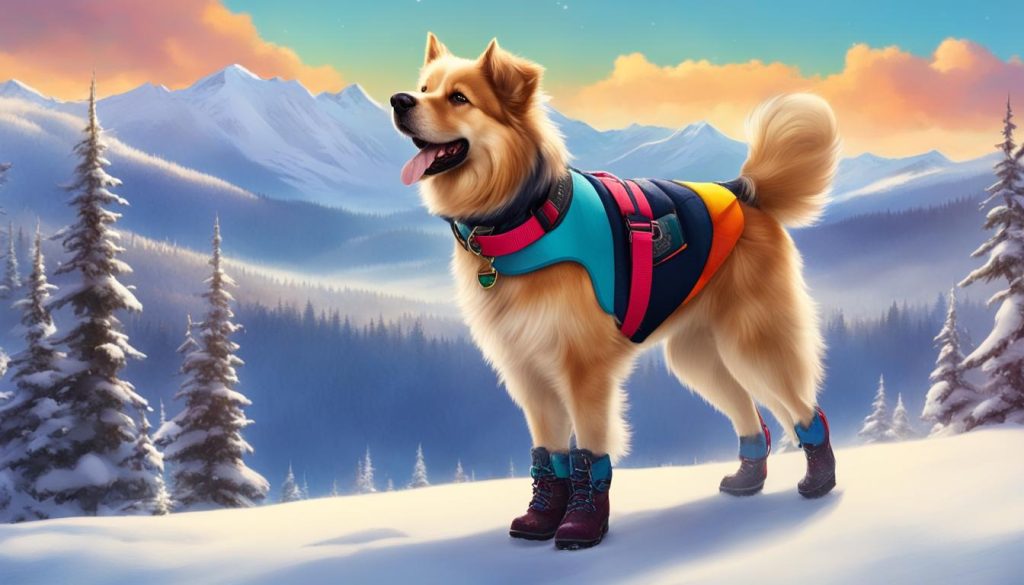
Provide Shelter for Outdoor Dogs
During the winter months, ensure that outdoor dogs have a warm and safe shelter to protect them from the cold weather. While it’s generally recommended to keep dogs indoors in cold temperatures, there are situations where outdoor dogs may need to spend time outside. In such cases, providing a well-insulated shelter is essential to keep them comfortable and protected.
The outdoor dog shelter should have a solid structure with a roof to shield dogs from snow and rain. Insulate the shelter with materials such as straw or blankets to help retain heat. I recommend that you regularly check and replace the bedding to keep it dry and clean. You can also use a heated pet bed or a heat lamp to provide additional warmth, ensuring that the temperature inside the shelter is above freezing.
When constructing an outdoor shelter, make sure it is elevated off the ground to prevent moisture from seeping in. The entrance should be covered with a flap or a door to minimize drafts. Consider placing the shelter in an area that is protected from wind and facing away from prevailing weather conditions. It’s also important to regularly check the shelter for any damage or signs of wear and tear.
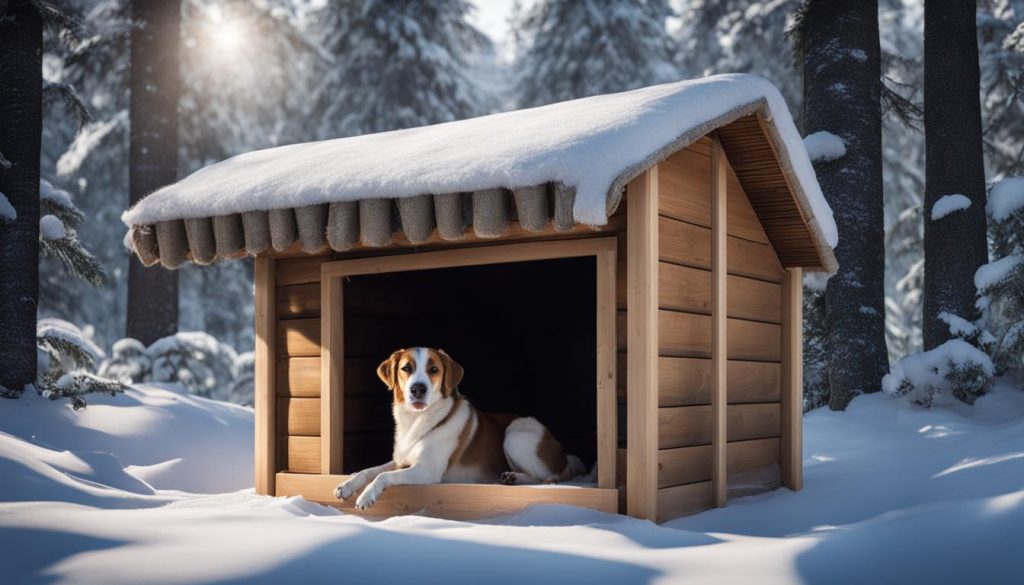
| Essential Features of an Outdoor Dog Shelter |
|---|
| Insulated structure |
| Elevated off the ground |
| Roof to shield from snow and rain |
| Well-insulated bedding |
| Flap or door to minimize drafts |
| Protected from wind and prevailing weather |
| Regular maintenance and inspections |
In addition to providing a shelter, please ensure that outdoor dogs have access to fresh water at all times. Consider using heated bowls or water bottle insulators to prevent freezing. Regularly check the water to ensure it hasn’t frozen or become contaminated.
To put it simply, even with a well-equipped outdoor shelter, dogs should not be left outside for extended periods in extreme cold weather. It’s best to bring them indoors whenever possible to keep them safe and comfortable.
Be Prepared for Winter Weather
As the winter season approaches, I would advise that you be prepared for the cold weather and ensure the safety and well-being of your dogs. Winter emergency preparedness for dogs involves stocking up on necessary supplies and taking proactive measures to protect your furry friends from the harsh elements. By following these tips, you can be confident that you’re ready to face any winter weather challenges that may arise.
Gather Essential Supplies
First and foremost, make sure you have an ample supply of food, water, and medications for your dogs. Plan ahead and ensure you have enough to last through any potential snowstorms or other weather-related disruptions. Additionally, consider investing in protective clothing for your dogs, such as winter coats or boots, to keep them warm and shielded from icy surfaces.
Prepare for Power Outages
Winter storms can sometimes result in power outages, leaving you and your dogs without heat or electricity. I highly suggest that you have a backup plan in place. Stock up on blankets and extra bedding to keep your dogs warm in case the power goes out. Investing in battery-powered or solar-powered heaters can also provide a source of heat during emergencies. Keep a flashlight and extra batteries handy, as well as a portable phone charger to stay connected.
Create a Winter Emergency Kit
Put together a winter emergency kit specifically for your dogs. Include items such as extra food and water bowls, a first aid kit, spare collars and leashes, and any necessary medications. It’s also a good idea to have a list of emergency contacts, including your veterinarian’s information, nearby animal hospitals, and local emergency services. Keep this kit easily accessible so you can grab it quickly in the event of an emergency.
| Winter Emergency Kit Checklist |
|---|
| Extra food and water bowls |
| First aid kit |
| Spare collars and leashes |
| Medications |
| Emergency contacts |
By taking the time to be prepared and stocking up on necessary supplies, you can ensure that you and your dogs are ready to face any winter weather events. Being proactive in your winter emergency preparedness for dogs will give you peace of mind and help keep your beloved pets safe and secure during the colder months.
Pay Attention to Your Dog’s Needs
During the winter season, be vigilant and attentive to your dog’s well-being. The cold weather can have adverse effects on dogs, and please monitor their health and ensure they’re comfortable. Here are some signs of discomfort to look out for and tips on how to take care of your dog during the winter months.
Signs of Discomfort in Dogs
When dogs are uncomfortable in the cold weather, they may exhibit certain signs. Keep an eye out for excessive shivering, whining, or reluctance to go outside. If your dog starts to lift or favor their paws, it could be a sign of frostbite. Reduced mobility, anxiety, or seeking warmth in unusual places are also indicators of discomfort. You should also pay attention to these signs and take the necessary steps to keep your dog safe and cozy.
Monitoring Your Dog’s Health in Winter
Regular veterinary check-ups are crucial for monitoring your dog’s health throughout the year. However, in winter, it’s particularly important to stay on top of any existing health conditions your dog may have. Cold weather can exacerbate certain conditions, such as arthritis or respiratory issues. Consult with your veterinarian to create a specific winter care plan for your dog. They may recommend adjustments to your dog’s diet, exercise routine, or additional medications to ensure their well-being.
Additionally, regularly inspect your dog’s paws for any signs of cold-related injuries. Ice balls can form between their toes, causing discomfort or even injury. Wipe their paws after walks to remove any ice or salt residue. Provide them with a warm and comfortable sleeping area indoors, away from drafty areas. By actively monitoring your dog’s health and taking preventive measures, you can make winter a safe and enjoyable season for them.
Final Thoughts
Winter dog care is essential to ensure the health and well-being of your furry friends during the cold season. By following these tips, you can keep your dogs safe, cozy, and happy throughout the winter months.
First and foremost, remember that dogs are vulnerable to the cold, just like us. Keep them indoors when the temperature drops, as they are at risk of frostbite and hypothermia. Create a warm and comfortable environment for them inside your home.
Additionally, be aware of potential dangers in the environment. Thump your car hood or honk the horn before starting your vehicle to prevent any cats from seeking warmth underneath. Watch out for toxic substances, such as ice melting products, and protect your dog’s paws from caustic substances.
Dressing your dog appropriately for the cold is also important. Short-haired dogs may benefit from wearing sweaters or coats during walks to keep them warm and prevent chills. Ensure you have a selection of warm clothing for your dog and change them if they get wet.
Try to provide adequate nutrition and hydration for your dogs during the winter months. They may require more food to maintain their energy levels. Additionally, make sure they always have access to fresh water, as outdoor water sources may freeze.
Antifreeze is extremely toxic to dogs, so be cautious of any spills and keep your dogs away from areas where it may be present. Ensure your dog has proper identification, including a collar with an ID tag and a microchip, in case they get lost in the winter snow.
If your dog is an outdoor pet, provide them with a warm and insulated shelter to protect them from the cold, wind, and wet conditions. Regularly change the bedding to keep it dry and comfortable.
Be prepared for winter weather by stocking up on supplies, including food, water, and medications for both your family and your dogs. Install carbon monoxide monitors to ensure the safety of your household.
Lastly, pay attention to your dog’s needs and monitor their health closely during the winter months. Look out for signs of discomfort or distress, such as whining, shivering, or reduced mobility. If you have any concerns, consult with your veterinarian.
By implementing these winter dog care tips, you can provide the necessary care and protection for your furry friends, ensuring that they stay healthy, happy, and safe all winter long.
FAQ
Are dogs able to withstand freezing temperatures?
No, dogs are just as susceptible to frostbite and hypothermia as humans. If it’s too cold for you to be outside comfortably, it’s too cold for your dogs as well. Keep them indoors where they can stay warm and cozy.
What are some potential hazards for dogs during cold weather?
Cats may seek warmth under car hoods, so thump the hood or honk the horn before starting your car. Additionally, be mindful of ice melting products on roads and walkways, as they can be toxic to dogs. Check your dog’s paws for ice balls and protect their feet from caustic substances.
Should dogs wear winter clothing?
Dogs with shorter coats may benefit from wearing sweaters or coats to keep them warm during walks. Ensure you have a selection of warm clothing for your dog and change them out if they get wet. This will help prevent your dog from getting chilled while outdoors.
Do dogs require more food during winter?
Dogs may require more food during the winter months to keep their energy levels up. Be sure to provide them with an appropriate amount of food based on their activity level. Additionally, remember that outdoor water sources can freeze, so ensure your dog always has access to fresh water.
Are antifreeze spills dangerous to dogs?
Yes, antifreeze is extremely toxic to dogs and even a small amount can be fatal. Be cautious of any spills and consider using antifreeze products that contain propylene glycol instead. Keep your dogs away from areas where antifreeze may be present, such as curbs where cars park.
How can I ensure my dog is identifiable in winter?
I recommend that you have proper identification for your dog, including a collar with an ID tag and a microchip. This will ensure that your dog can be easily returned to you if they do get lost.
What should I do if I need to keep my dog outside in winter?
If it’s necessary to keep your dog outside for a period of time in cold weather, provide them with a warm and solid shelter. The shelter should be insulated, with a floor and thick bedding to protect them from the cold, wind, and wet conditions. Regularly change the bedding to keep it dry and comfortable.
How should I prepare for winter weather with my dog?
I recommend that you be prepared with an ample supply of food, water, and medications for both your family and your dogs. Additionally, consider installing carbon monoxide monitors to ensure the safety of your entire household.
What signs indicate that my dog is uncomfortable in the cold?
If your dog is whining, shivering, anxious, or displaying reduced mobility, bring them indoors. Frostbite can be difficult to detect early, so regularly check your dog’s paws for any signs of cold-related injuries. Consult with your veterinarian if you have any concerns or if your dog has pre-existing health conditions that may be exacerbated by cold weather.


